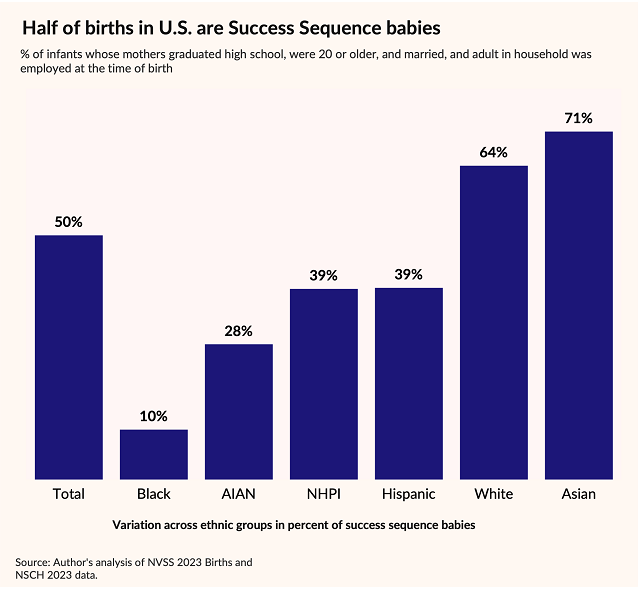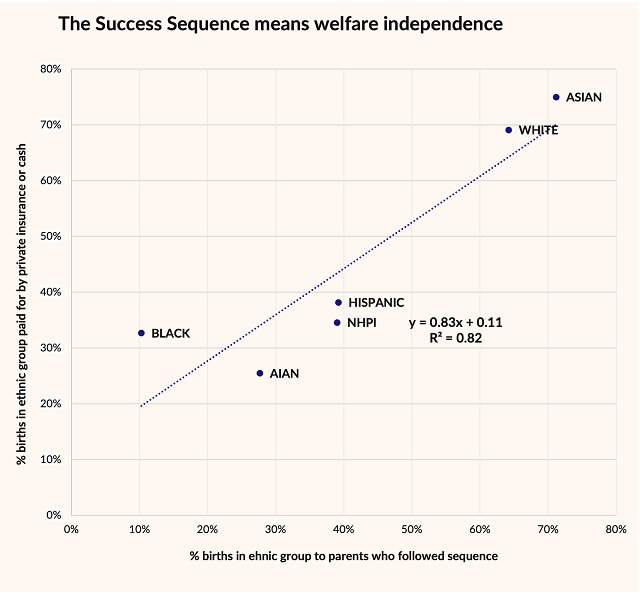Highlights
- The major factor driving the ethnic variation in Success Sequence babies was marriage. Post This
- A straight-line relationship between Success Sequence adherence and welfare independence accounted for 94% of the variation across ethnic groups in welfare non-reliance. Post This
- To have fewer children in poverty, we need to encourage more young people to complete their educations, get jobs, and wait until marriage to have kids. Post This
In order for a couple to have a child without becoming poor or having to rely on government assistance, there is a path they can follow that greatly enhances their chances of achieving an independent, financially secure family life.
That path, sometimes called the “Success Sequence,” involves the following stepping stones:
- Get at least a high school degree
- Get a full-time job
- Marry before having children
Research by Wendy Wang and Brad Wilcox has shown that 97% of young adults who adhere to the Success Sequence escape poverty by their late 20s and early 30s. Furthermore, 86% of young adults who followed these steps reached the middle or upper class. The benefits of the sequence applied to young adults across racial and economic lines.
How many babies born in the U.S. today have parents who followed the Success Sequence? How does the proportion of Success Sequence babies vary across racial and ethnic groups? And how does the proportion relate to the method of payment for the baby’s delivery and postnatal care (i.e., how many deliveries were paid for by private insurance or parental cash, as opposed to Medicaid, state government welfare programs, or charity)? I used 2023 birth certificate1 and National Child Health Survey2 data to answer these questions.
Half of U.S. Births are Success Sequence Babies
About 50% of babies born in the U.S. in 2023 had mothers who, at the time of the child’s birth:3
-
had completed high school (89%), and
-
were 20 years old or older (96%), and
-
were married (60%), and
-
were themselves employed or lived with a spouse or partner who was working (88%).
Majorities of Asian and White Births Are Success Sequence Babies
The proportion of births to parents who followed this Success Sequence (based on the 4 characteristics listed above4) varied greatly across racial and ethnic groups. As the figure below shows, a 71% majority of Asian births and a 64% majority of White births qualified. But only 10% of Black births and 39% of Hispanic births did so.

The major factor driving the ethnic variation was marriage: 88% of Asian couples and 73% of White couples were married at the birth of their child. By contrast, only 31% of Black parents and 46% of Hispanic parents were married. Variation in parental employment also contributed, with 93% of White newborns and 91% of Asian newborns having at least one employed parent, while only 58% of Black newborns had a working parent in the home.
In past years, there was more variation across ethnic groups in rates of high school graduation and teen childbirth among new parents. But rising rates of high-school diploma awards and falling rates of teen childbearing have narrowed these gaps.
Welfare Independence is Closely Related to Success Sequence Adherence
The extent to which payment for a newborn’s delivery and postnatal care is not reliant on taxpayer dollars or the kindness of strangers is closely related to the extent to which the baby’s parents have stuck to the Success Sequence pathway. In fact, 75% of Asian births and 69% of White births were paid for by private dollars, whereas the same was true for only 33% of Black births and 38% of Hispanic births. As shown in the figure below, for every 10 percentage-point increase in the extent to which parents in an ethnic group stuck to the pathway, there was an 8.3 percentage-point increase in non-reliance on welfare for payment of a baby’s delivery. A straight-line relationship between success sequence adherence and welfare independence accounted for 82% of the variation across ethnic groups in welfare non-reliance.

Note: Relationship between percentage of 2023 births in each ethnic group to parents who followed success sequence pathway and percentage of births in each ethnic group which were paid for by private insurance or self-pay, rather than by Medicaid, state welfare programs, or charity.
Reducing Child Poverty and Welfare Dependence
The policy implications of this analysis are clear. In order to have fewer children growing up in poverty or welfare dependence, we need to encourage more young couples to complete their educations, get jobs, and wait until marriage to have children. The U.S. has already made progress in reducing childbearing by teenagers and increasing high school completion in all racial and ethnic groups. But rates of unmarried childbearing and parental non-employment remain stubbornly high, especially among Black, Hispanic, and American Indian young adults.
Families, public and private schools, and religious institutions need to provide better and more principled education about marriage and human reproduction to teenaged students. Parents, state and local child welfare institutions, and family courts need to be more insistent and rigorous in identifying fathers of all newborns and requiring that those fathers work to provide financial support for their offspring. As matters stand now, most teen births and unmarried births in the U.S. wind up being subsidized by taxpayer dollars.5
Editor's Note: On June 19, the figures in this article were updated by the author using microdata from the NVSS 2023 Final Births: U.S. data file.
Nicholas Zill is a research psychologist and a senior fellow of the Institute for Family Studies. He directed the National Survey of Children, a longitudinal study that produced widely cited findings on children’s life experiences and adjustment following parental divorce.
*Photo credit: Shutterstock
1. National Vital Statistics Reports, Vol. 74, No. 1, March 18, 2025. Tables 11 & 13.
2. 2023 National Survey of Children’s Health, public use data file downloaded from Census.gov website.
3. I used a modified definition of the Success Sequence in my analysis, one that includes avoidance of teen childbearing, in keeping with earlier work, such as Nord et al., 1994, Developing an index of educational risk from health and social characteristics known at birth. Bulletin of the New York Academy of Medicine.
4. Information about maternal age, educational attainment, and marital status was obtained from birth certificate data. Information about parental employment was obtained from the author’s analysis of 2023 National Child Health Survey data. The Success Sequence percentage was obtained as the product of the four component percentages. It was based on individual child records.
5. National Vital Statistics Reports, Vol. 74, No. 1, March 18, 2025. Tables 13,14, & 19.













